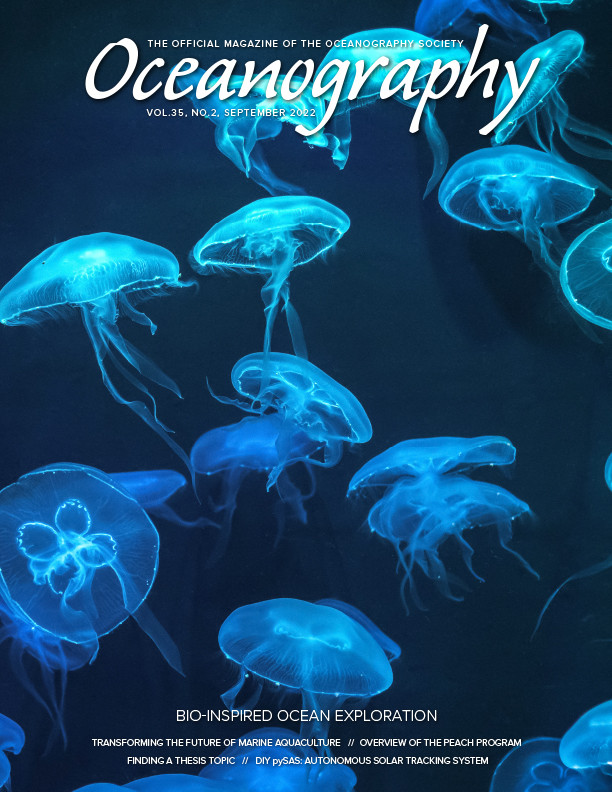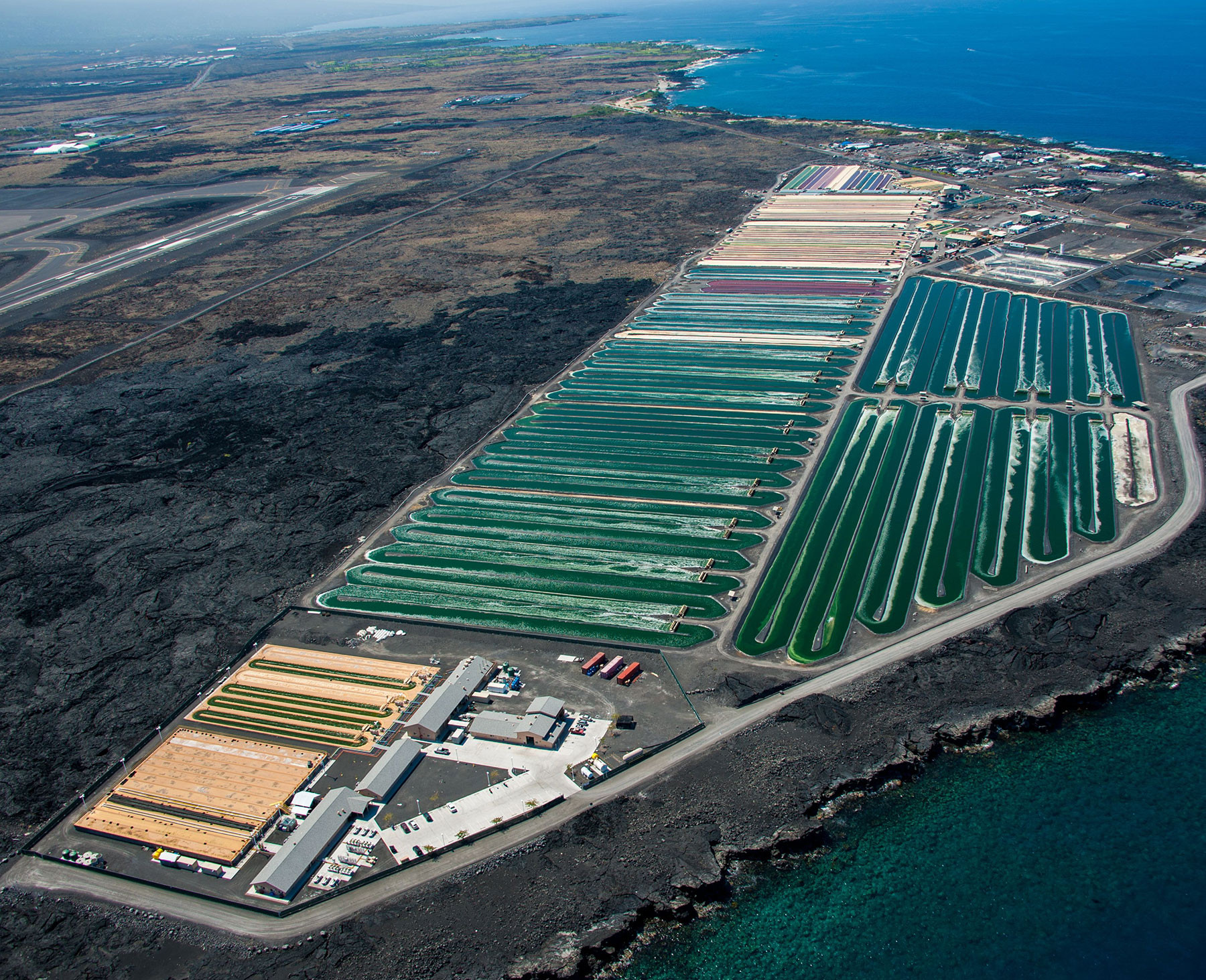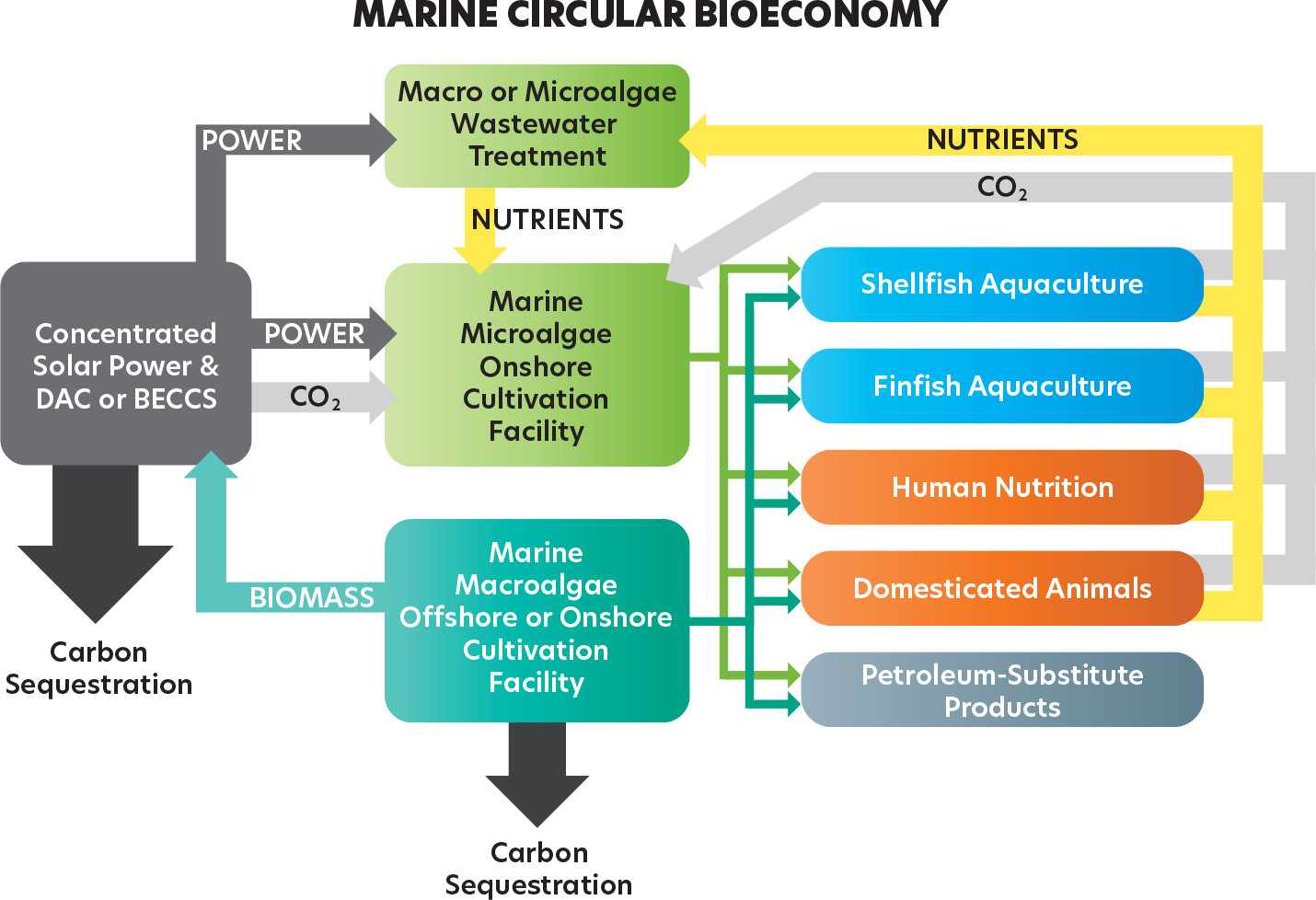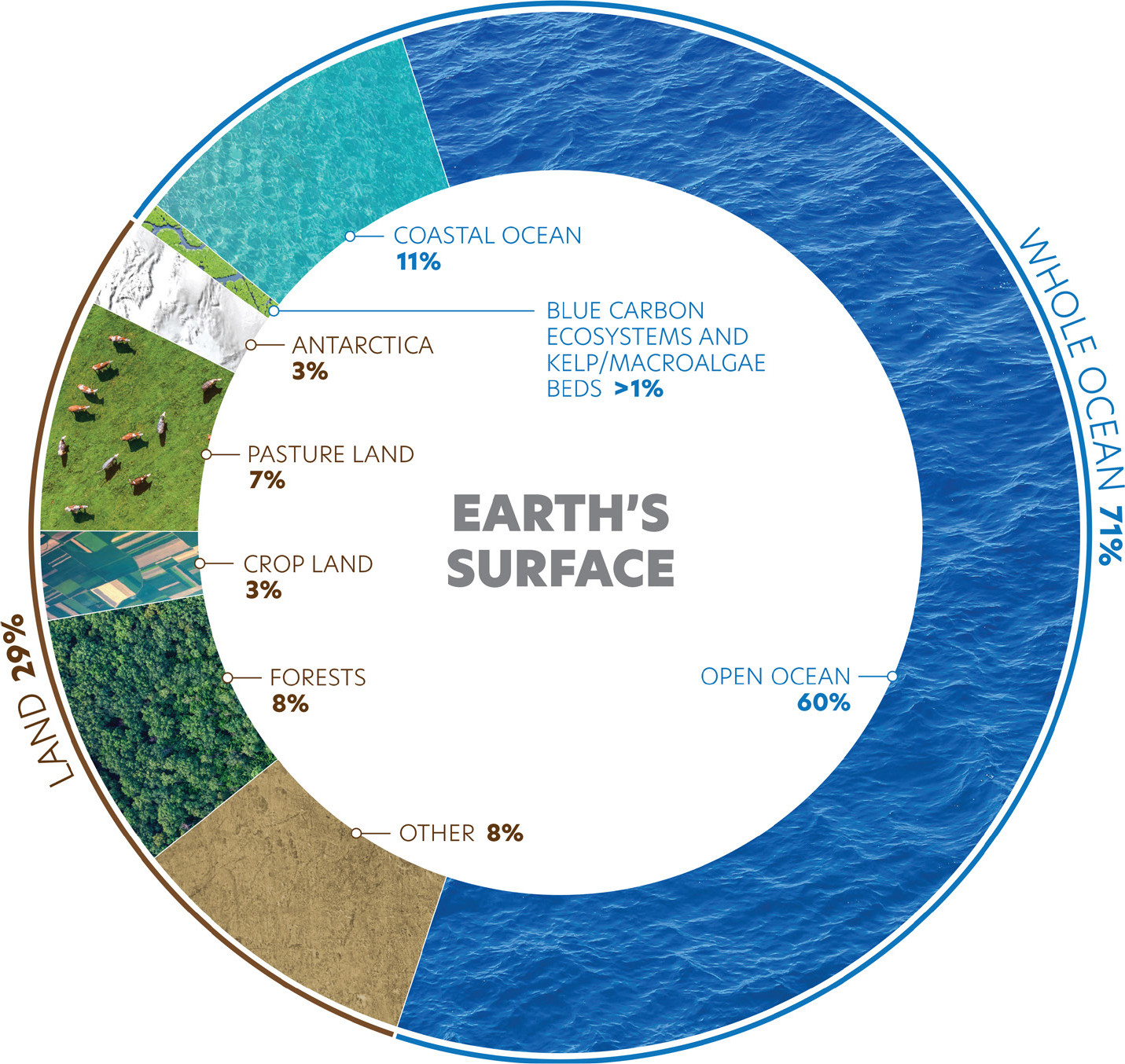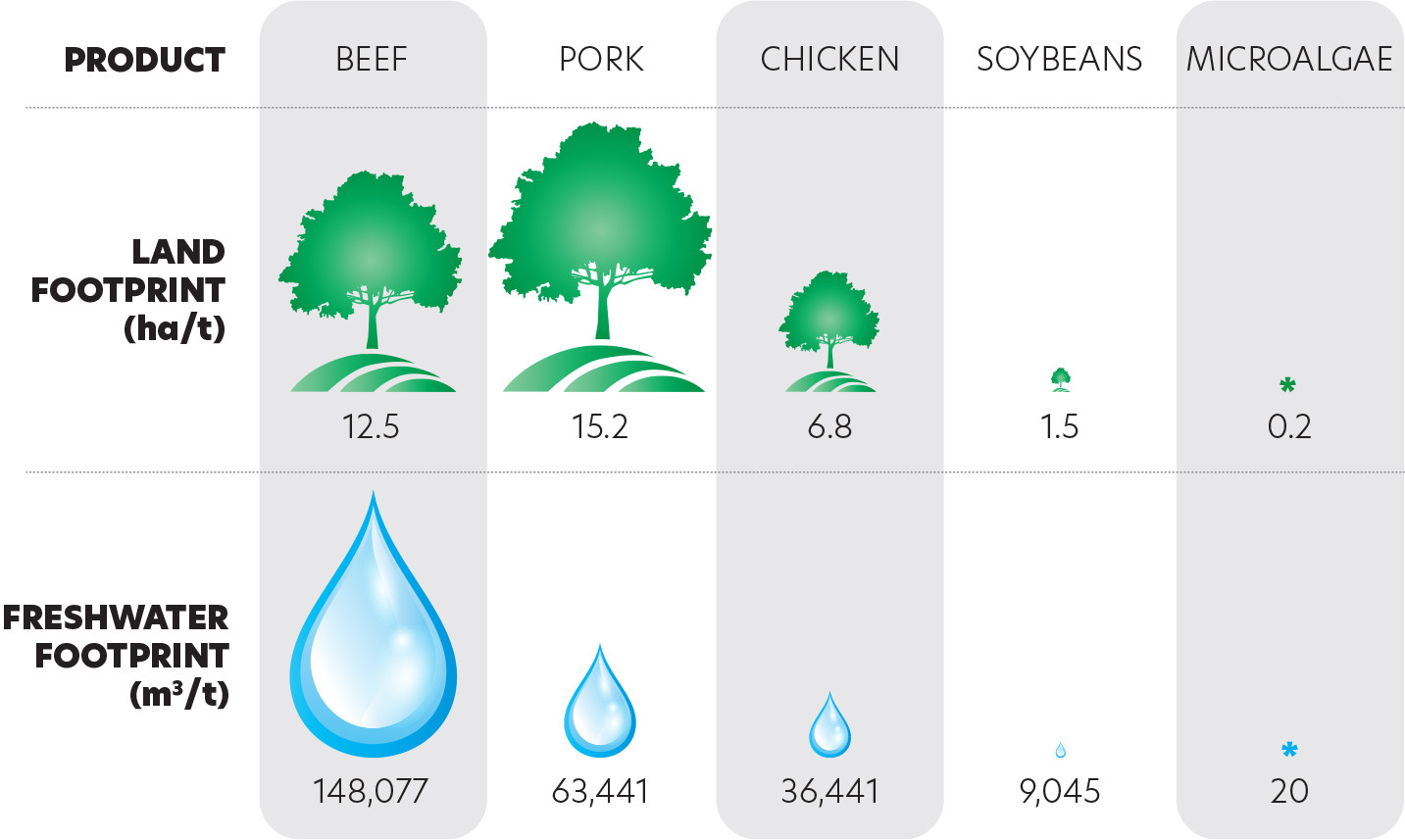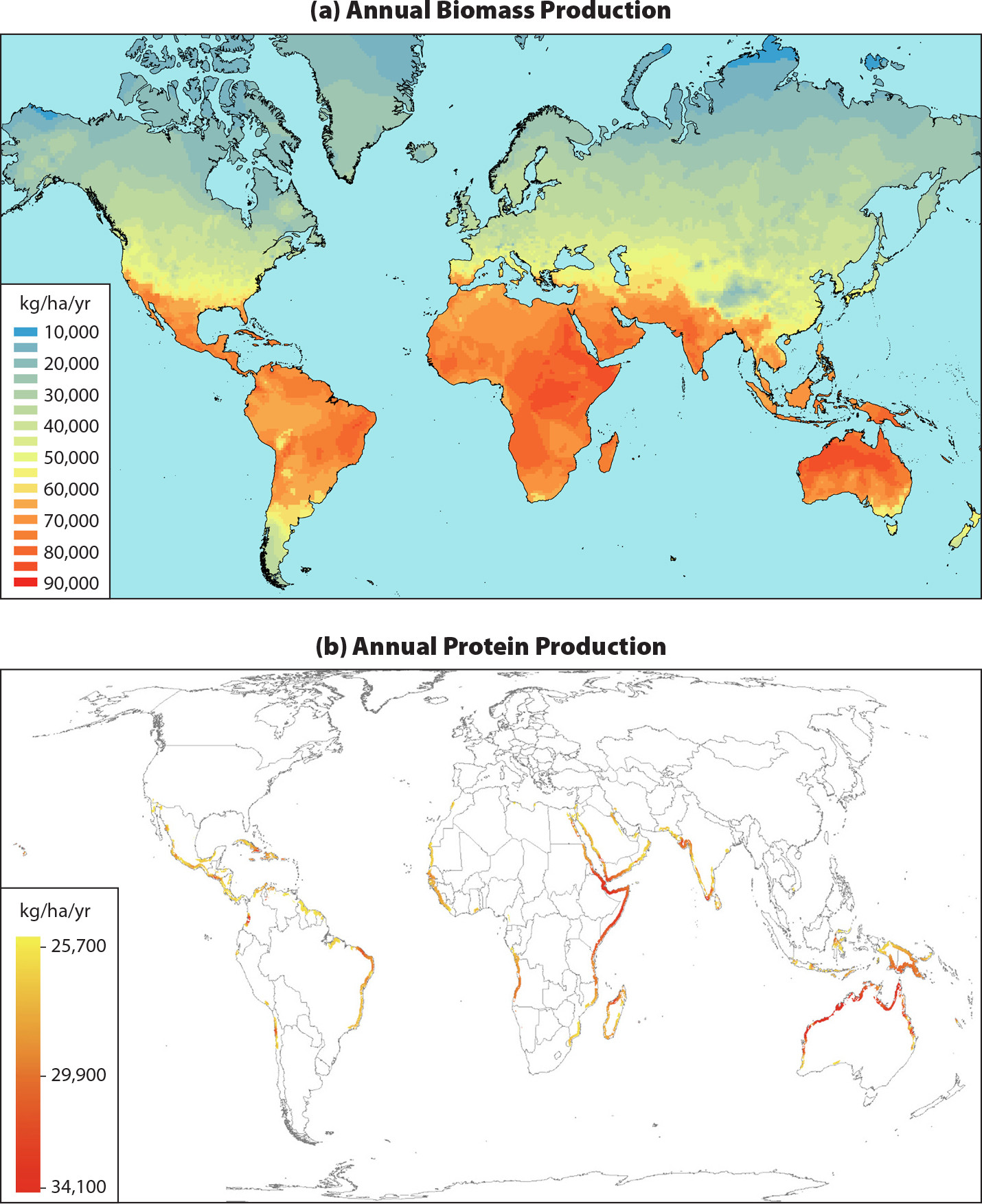Alexander, R.B, R.A. Smith, G.E. Schwarz, E.W. Boyer, J.V. Nolan, and J.W. Brakebill. 2008. Differences in phosphorus and nitrogen delivery to the Gulf of Mexico from the Mississippi River Basin. Environmental Science & Technology 42(3):822–830, https://doi.org/10.1021/es0716103.
Allan, J.R., H.P. Possingham, S.C. Atkinson, A. Waldron, M. Di Marco, S.H.M. Butchart, V.M. Adams, W.D. Kissling, T. Worsdell, C. Sandbrook, and others. 2022. The minimum land area requiring conservation attention to safeguard biodiversity. Science 376:1,094–1,101, https://doi.org/10.1126/science.abl9127.
Araújo, R., V.C. Fatima, S. López, J.A.I. Costa, B.F. Silvia, G.T. Manuel, G. Fatemeh, I. Tanel, L. Martial, M.M. Micheal, and others. 2021. Current status of the algae production industry in Europe: An emerging sector of the blue bioeconomy. Frontiers in Marine Science 7:626389, https://doi.org/10.3389/fmars.2020.626389.
Baker, S.E., J.K. Stolaroff, G. Peridas, S.H. Pang, H. Goldstein, M. Hannah, F.R. Lucci, W. Li, E.W. Slessarev, J. Pett-Ridge, and others. 2020. Getting to Neutral: Options for Negative Carbon Emissions in California. US Department of Energy, Office of Science and Technology Information, Technical Report, https://doi.org/10.2172/1597217.
Bank, M.S., P.W. Swarzenski, G. Bianchi, M. Metian, Y.S. Ok, and C.M. Duarte. 2021. Reimagining aquaculture in the Global South. Science 371:247–248, https://doi.org/10.1126/science.abi5015.
Beal, C.M., L.N. Gerber, S. Thongrod, W. Phromkunthong, V. Kiron, J. Granados, I. Archibald, C.H. Greene, and M.E. Huntley. 2018a. Marine microalgae commercial production improves sustainability of global fisheries and aquaculture. Scientific Reports 8:15064, https://doi.org/10.1038/s41598-018-33504-w.
Beal, C.M., I. Archibald, M.E. Huntley, C.H. Greene, and Z.I. Johnson. 2018b. Integrating algae with bioenergy carbon capture and storage (ABECCS) increases sustainability. Earth’s Future 6:524–542, https://doi.org/10.1002/2017EF000704.
Belton, B., D.C. Little, W. Zhang, P. Edwards, M. Skladany, and S.H. Thilsted. 2020. Farming fish in the sea will not nourish the world. Nature Communications 11:5804, https://doi.org/10.1038/s41467-020-19679-9.
Benemann, J.R. 2013. Microalgae for biofuels and animal feeds. Energies 6(11):5,869–5,886, https://doi.org/10.3390/en6115869.
Boulton, C.A., T.M. Lenton, and N. Boers. 2022. Pronounced loss of Amazon rainforest resilience since the early 2000s. Nature Climate Change 12:271–278, https://doi.org/10.1038/s41558-022-01287-8.
Boyd, P.W., S. Sundby, and H.-O. Pörtner. 2014. Cross-chapter box on net primary production in the ocean. Pp. 133–136 in Climate Change 2014: Impacts, Adaptation, and Vulnerability. Part A: Global and Sectoral Aspects. Contribution of Working Group II to the Fifth Assessment Report of the Intergovernmental Panel on Climate Change. C.B. Field, V.R. Barros, D.J. Dokken, K.J. Mach, M.D. Mastrandrea, T.E. Bilir, M. Chatterjee, K.L. Ebi, Y.O. Estrada, R.C. Genova, B. Girma, E.S. Kissel, A.N. Levy, S. MacCracken, P.R. Mastrandrea, and L.L. White, eds, Cambridge University Press, Cambridge, UK, and New York, NY, USA.
Boyd, P.W., L.T. Bach, C.L. Hurd, E. Paine, J.A. Raven, and V. Tamsitt. 2022. Potential negative effects of ocean afforestation on offshore ecosystems. Nature Ecology and Evolution 6:675–683, https://doi.org/10.1038/s41559-022-01722-1.
Buck, B.H., and R. Langan, eds. 2017. Aquaculture Perspective of Multi-Use Sites in the Open Ocean: The Untapped Potential for Marine Resources in the Anthropocene. Springer Nature, Cham, Switzerland, https://doi.org/10.1007/978-3-319-51159-7_2.
Buck, B.H., and B. Grote. 2018. Seaweed in high-energy environments: Protocol to move Saccharina cultivation offshore. Pp. 3–36 in Protocols for Macroalgae Research. B. Charrier, T. Wichard, and C.R.K. Reddy, eds, CRC Press, Boca Raton, FL, USA, https://doi.org/10.1201/b21460-1.
Cai, J., and P.S. Leung. 2017. Short-Term Projection of Global Fish Demand and Supply Gaps. FAO Fisheries and Aquaculture Technical Paper No. 607. Rome, Italy, 128 pp.
Conforti, P., ed. 2011. Looking Ahead in World Food and Agriculture: Perspectives to 2050. FAO, Agriculture and Economic Development Analysis Division, Rome, Italy, 539 pp.
Cordell, D., J.-O. Drangert, and S.B. White. 2009. The story of phosphorus: Global food security and food for thought. Global Environmental Change 19(2):292–305, https://doi.org/10.1016/j.gloenvcha.2008.10.009.
Costello, C., L. Cao, S. Gelcich, M.A. Cisneros-Mata, C.M. Free, H.E. Froehlich, C.D. Golden, G. Ishimura, J. Maier, I. Macadam-Somer, and others. 2020. The future of food from the sea. Nature 588:95–100, https://doi.org/10.1038/s41586-020-2616-y.
de Wit, M., J. Hoogzaad, and C. von Daniels. 2020. The Circularity Gap Report 2020. Platform for Accelerate the Circular Economy, https://pacecircular.org/sites/default/files/2020-01/Circularity Gap Report 2020.pdf.
Dirzo, R., and P.H. Raven. 2003. Global state of biodiversity and loss. Annual Review of Environmental Resources 28:137–167, https://doi.org/10.1146/annurev.energy.28.050302.105532.
DOE (Department of Energy). 2016a. 2016 Billion-Ton Report: Advancing Domestic Resources for a Thriving Bioeconomy, Volume 1: Economic Availability of Feedstocks. M.H. Langholtz, B.J. Stokes, and L.M. Eaton, leads, ORNL/TM-2016/160, Oak Ridge National Laboratory, Oak Ridge, TN, 448 pp., https://doi.org/10.2172/1271651.
DOE. 2016b. National Algal Biofuels Technology Review. US Department of Energy, Office of Energy Efficiency and Renewable Energy, Bioenergy Technologies Office, 198 pp.
Duff, H., C. Faerron Guzmán, A. Almada, C. Golden, and S. Myers. 2020. Today’s solutions for the future of food. Planetary Health Case Studies: An Anthology of Solutions, Case Study 07, https://www.planetaryhealthalliance.org/phcs61820.
FAO (Food and Agriculture Organization). 2019. World Fertilizer Trends and Outlook to 2022. Food and Agriculture Organization of the United Nations, Rome, Italy, 28 pp.
FAO. 2021. FAOSTAT - Food and Agriculture Statistics. Food and Agriculture Organization of the United Nations, Rome, Italy, https://www.fao.org/faostat/en/#data.
FAO. 2022. AQUASTAT - Global Information System on Water and Agriculture. Food and Agriculture Organization of the United Nations, Rome, Italy, https://www.fao.org/aquastat/en/.
Field, C.B., M.J. Behrenfeld, J.T. Randerson, and P. Falkowski. 1998. Primary production of the biosphere: Integrating terrestrial and oceanic components. Science 281:237–240, https://doi.org/10.1126/science.281.5374.237.
Foley, J.A., R.S. Defries, G.P. Asner, C. Barford, G. Bonan, S.R. Carpenter, F.S. Chapin, M.T. Coe, G.C. Daily. H.K. Gibbs, and others. 2005. Global consequences of land use. Science 309:570–574, https://doi.org/10.1126/science.1111772.
Foley, J.A., N. Ramankutty, K.A. Brauman, E.S. Cassidy, J.S. Gerber, M. Johnston, N.D. Mueller, C. O’Connell, D.K. Ray, P.C. West, and others. 2011. Solutions for a cultivated planet. Nature 478:337–342, https://doi.org/10.1038/nature10452.
Gatti, L.V., L.S. Basso, J.B. Miller, M. Gloor, L. Gatti Domingues, H.L.G. Cassol, G. Tejada, L.E.O. Aragão, C. Nobre, W. Peters, and others. 2021. Amazonia as a carbon source linked to deforestation and climate change. Nature 595:388–393, https://doi.org/10.1038/s41586-021-03629-6.
Gerber, L.N., J.W. Tester, C.M. Beal, M.E. Huntley, and D.L. Sills. 2016. Target cultivation and financing parameters for sustainable production of fuel and feed from microalgae. Environmental Science & Technology 50(7):3,333–3,341, https://doi.org/10.1021/acs.est.5b05381.
Godfray, H.C.J., J.R. Beddington, I.R. Crute, L. Haddad, D. Lawrence, J.F. Muir, J. Pretty, S. Robinson, S.M. Thomas, and C. Toulmin. 2010. Food security: The challenge of feeding 9 billion people. Science 327:812–818, https://doi.org/10.1126/science.1185383.
Greene, C.H., M.E. Huntley, I. Archibald, L.N. Gerber, D.L. Sills, J. Granados, J.W. Tester, C.M. Beal, M.J. Walsh, R.R. Bidigare, and others. 2016. Marine microalgae: Climate, energy, and food security from the sea. Oceanography 29(4):10–15, https://doi.org/10.5670/oceanog.2016.91.
Greene, C.H., M.E. Huntley, I. Archibald, L.N. Gerber, D.L. Sills, J. Granados, C.M. Beal, and M.J. Walsh. 2017. Geoengineering, marine microalgae, and climate stabilization in the 21st century. Earth’s Future 5(3):278–284, https://doi.org/10.1002/2016EF000486.
Huntley, M.E., and D.J. Redalje. 2007. CO2 mitigation and renewable oil from photosynthetic microbes: A new appraisal. Mitigation and Adaptation Strategies for Global Change 12:573–608, https://doi.org/10.1007/s11027-006-7304-1.
Huntley, M.E., Z.I. Johnson, S.L. Brown, D.L. Sills, L. Gerber, I. Archibald, S.C. Machesky, J. Granados, C. Beal, and C.H. Greene. 2015. Demonstrated large-scale production of marine microalgae for fuels and feed. Algal Research 10:249–265, https://doi.org/10.1016/j.algal.2015.04.016.
Khan, M.I., J.H. Shin, and J.D. Kim. 2018. The promising future of microalgae: Current status, challenges, and optimization of a sustainable and renewable industry for biofuels, feed, and other products. Microbial Cell Factories 17(36), https://doi.org/10.1186/s12934-018-0879-x.
Krogh, A. 2020. State of the Tropical Rainforest. Rainforest Foundation Norway, Oslo, Norway, 32 pp.
Lei, X., ed. 2021. Seaweed and Microalgae as Alternative Sources of Protein. Burleigh Dodds Science Publishing, London, 344 pp.
Lenton, T.M. 2014. The global potential for carbon dioxide removal. Pp. 52–79 in Geoengineering of the Climate System. R.E. Hester and R.M. Harrison, eds, Royal Society of Chemistry, Cambridge, UK.
Macreadie, P.I., A. Anton, J.A Raven, N. Beaumont, R.M. Connolly, D.A. Friess, J.J. Kelleway, H. Kennedy, T. Kuwae, P.S. Lavery, and others. 2019. The future of blue carbon science. Nature Communications 10:3998, https://doi.org/10.1038/s41467-019-11693-w.
Moody, J.W., C.M. McGinty, and J.C. Quinn. 2014. Global evaluation of biofuel potential from microalgae. Proceedings of the National Academy of Sciences of the United States of America 111:8,691–8,696, https://doi.org/10.1073/pnas.1321652111.
Moomaw, W., I. Berzin, and A. Tzachor. 2017. Cutting out the middle fish: Marine microalgae as the next sustainable omega-3 fatty acids and protein source. Industrial Biotechnology 13(5):234–243, https://doi.org/10.1089/ind.2017.29102.wmo.
Naylor, R.L., R.J. Goldburg, J.H. Primavera, N. Kautsky, M.C.M. Beveridge, J. Clay, C. Folke, J. Lubchenco, H. Mooney, and M. Troell. 2000. Effect of aquaculture on world fish supplies. Nature 405: 1,017–1,024, https://doi.org/10.1038/35016500.
Naylor, R.L., R.W. Hardy, A.H. Buschmann, S.R. Bush, L. Cao, D.H. Klinger, D.C. Little, J. Lubchenco, S.E. Shumway, and M. Troell. 2021. A 20-year retrospective review of global aquaculture. Nature 591:551–563, https://doi.org/10.1038/s41586-021-03308-6.
Nellemann, C., E. Corcoran, C.M. Duarte, L. Valdés, C. De Young, L. Fonseca, and G. Grimsditch, eds. 2009. Blue Carbon: The Role of Healthy Oceans in Binding Carbon. A Rapid Response Assessment. United Nations Environment Programme, GRID-Arendal, 80 pp.
Parodi, A., A. Leip, I.J.M. De Boer, P.M. Slegers, F. Ziegler, E.H.M. Temme, M. Herrero, H. Tuomisto, H. Valin, C.E. Van Middelaar, and others. 2018. The potential of future foods for sustainable and healthy diets. Nature Sustainability 1:782–789, https://doi.org/10.1038/s41893-018-0189-7.
Ritchie, H., and M. Roser. 2019. Land use. Our World in Data, September 2019, https://ourworldindata.org/land-use#breakdown-of-global-land-use-today.
Ryther, J.H. 1969. Photosynthesis and fish production from the sea. Science 166:72–76, https://doi.org/10.1126/science.166.3901.72.
Scott-Buechler, C.M., and C.H. Greene. 2019. Role of the ocean in climate stabilization. Pp. 109–130 in Bioenergy with Carbon Capture and Storage: Using Natural Resources for Sustainable Development. J.C.M. Pires and A.L.C. Goncalves eds, Elsevier, London, UK.
Shah, M.M.R., G.A. Lutzu, M.D.A. Asraful Alam, P. Sarker, M.A.K. Chowdhury, A. Parsaeimehr, Y. Liang, and M. Daroch. 2018. Microalgae in aquafeeds for a sustainable aquaculture industry. Journal of Applied Phycology 30:197–213, https://doi.org/10.1007/s10811-017-1234-z.
Springmann, M., H. Charles, J. Godfray, M. Rayner, and P. Scaborough. 2016. Analysis and valuation of the health and climate change cobenefits of dietary change. Proceedings of the National Academy of Sciences of the United States of America 113:4,146–4,151, https://doi.org/10.1073/pnas.1523119113.
Tilman, D., C. Balzer, J. Hill, and B.L. Befort. 2011. Global food demand and the sustainable intensification of agriculture. Proceedings of the National Academy of Sciences of the United States of America 108(50):20,260–20,264, https://doi.org/10.1073/pnas.1116437108.
Ullmann, J., and D. Grimm. 2021. Algae and their potential for a future bioeconomy, landless food production, and the socio-economic impact of an algae industry. Organic Agriculture 11:261–267, https://doi.org/10.1007/s13165-020-00337-9.
USDA (United States Department of Agriculture). 2018. Food Data Central, https://fdc.nal.usda.gov/.
Walsh, M.J., L. Gerber Van Doren, D.L Sills, I. Archibald, C.M. Beal, X.G. Lei, M.E. Huntley, Z. Johnson, and C.H. Greene. 2016. Algal food and fuel coproduction can mitigate greenhouse gas emissions while improving land and water-use efficiency. Environmental Research Letters 11:114006, https://doi.org/10.1088/1748-9326/11/11/114006.
Wang, Y., S.M. Tibbetts, and P.J. McGinn. 2021. Microalgae as sources of high-quality protein for human food and protein supplements. Foods 2021 10:3002, https://doi.org/10.3390/foods10123002.
Wilcox, J., P.C. Psarras, and S. Ligouri. 2017. Assessment of reasonable opportunities for direct air capture. Environmental Research Letters 12:065001, https://doi.org/10.1088/1748-9326/aa6de5.
Willett, W., J. Rockstrom, B. Loken, M. Springmann, T. Lang, S. Vermeulen, T. Garnett, D. Tilman, F. DeClerck, A. Wood, and others. 2019. Food in the Anthropocene: The EAT–Lancet Commission on healthy diets from sustainable food systems. Lancet 393:447–492, https://doi.org/10.1016/S0140-6736(18)31788-4.
World Hunger and Poverty Facts and Statistics. 2018. https://www.worldhunger.org/world-hunger-and-poverty-facts-and-statistics/.
World Resources Institute. 2019. Creating a Sustainable Future. A Menu of Solutions to Feed Nearly 10 Billion People by 2050. World Resources Report, Washington, DC, USA, 558 pp.
Zurek, M., A. Hebinck, and O. Selomane. 2022. Climate change and the urgency to transform food systems. Science 376:1,416–1,421, https://doi.org/10.1126/science.abo2364.

